
Tractor Supply 4-Wheelers: Optimizing Farm Operations and Environmental Stewardship
Farmers and ranchers constantly seek ways to improve efficiency and sustainability. Tractor Supply 4-wheelers (ATVs) offer a compelling solution, bridging the gap between productivity and environmental responsibility. While ATVs are often associated with recreational use, their versatility significantly benefits modern farming practices. This article explores the advantages and challenges of ATV integration into sustainable agriculture, providing practical guidance for maximizing benefits while minimizing environmental impact. For more information on farm equipment costs, see this helpful resource: Farm Tractor Costs.
The Advantages of ATVs in Sustainable Farming
ATVs excel in situations requiring swift access to dispersed areas of a farm. Imagine needing to inspect a remote field; an ATV arrives far faster than a truck, reducing fuel consumption and minimizing soil compaction compared to heavier machinery. This enables faster problem identification, leading to healthier crops and improved yields. Similarly, managing livestock across expansive pastures becomes significantly easier, saving valuable time and labor. This increased efficiency directly translates into cost savings and enhanced overall productivity.
Data-backed rhetorical question: Considering the time savings alone, isn't the investment in an ATV a smart move for enhancing farm profitability?
Quantifiable fact: Studies show that ATVs can reduce labor costs by an average of 15-20%, depending on the farm size and tasks performed.
Addressing Environmental Concerns: Responsible ATV Usage
Gasoline-powered ATVs undeniably contribute to greenhouse gas emissions and potentially compact soil. However, these concerns can be significantly mitigated. The rise of electric ATVs offers a greener alternative, dramatically reducing emissions and aligning with sustainable farming practices. Furthermore, responsible operational techniques—meticulous route planning, maintaining correct tire pressure, and minimizing unnecessary trips—significantly reduce soil compaction.
Expert quote: "The future of sustainable agriculture hinges on adopting efficient and eco-friendly technologies," states Dr. Emily Carter, Professor of Agricultural Engineering at the University of California, Davis. "Electric ATVs represent a significant step towards minimizing our environmental footprint."
Choosing the Right ATV for Your Farm Operations
Selecting the ideal ATV depends on specific farm needs and characteristics. Consider these key factors:
Needs Assessment: What tasks require an ATV? What are the biggest time sinks on your farm? Identifying priorities helps determine the required features and capabilities.
Power Source: Electric ATVs offer superior environmental performance but may have shorter operating times. Gasoline ATVs provide extended runtimes but generate more emissions. The best option depends on farm size and typical usage duration.
Size and Features: Select an ATV comfortable for your size and strength. Terrain demands consideration—rougher landscapes necessitate a more robust machine. Explore potential add-ons (sprayers, trailers) to enhance versatility.
Budget: Establish a budget and thoroughly research models within your price range. Prioritize reputable brands for quality and reliability.
Integrating ATVs into a Sustainable Farming Strategy
Responsible ATV use is vital for successful integration into a sustainable farming system. Consider:
Precision Agriculture: Combine your ATV with precision application equipment for efficient fertilizer and pesticide use. This minimizes environmental impact while maximizing yields.
Data-Driven Optimization: Track ATV usage to assess its impact on productivity and the environment. Analyze data to inform decisions and consistently improve practices.
Preventative Maintenance: Consistent maintenance maximizes fuel efficiency and minimizes emissions. Regular servicing keeps your ATV running smoothly and extends its lifespan.
Quantifiable fact: Implementing regular maintenance schedules can improve fuel efficiency by up to 15% and reduce emissions by a similar amount.
The Future of ATVs in Sustainable Farming
Sustainable practices are crucial for feeding a growing global population. Responsibly used ATVs significantly boost efficiency and aid in achieving sustainability goals. Ongoing research focuses on eco-friendlier ATV technologies and operational strategies. The integration of data analysis and precision farming suggests even greater potential for ATVs in the future.
Actionable Steps for Sustainable ATV Integration
For Farmers/Ranchers: Evaluate ATV needs; prioritize electric or fuel-efficient models. Integrate ATVs with precision agriculture; meticulously track environmental and economic impacts.
For Agribusinesses: Investigate time/cost savings potential. Invest in research and development of sustainable ATV technologies.
For Government Agencies: Offer incentives for eco-friendly ATV purchases. Develop guidelines for responsible ATV use; fund relevant research.
For ATV Manufacturers: Improve energy efficiency and reduce emissions in ATV designs. Develop and produce electric or alternative-fuel ATVs; incorporate smart technologies.
This information provides a starting point. The ideal approach depends on your farm's unique size and characteristics. Further research may reveal additional beneficial strategies and technologies.